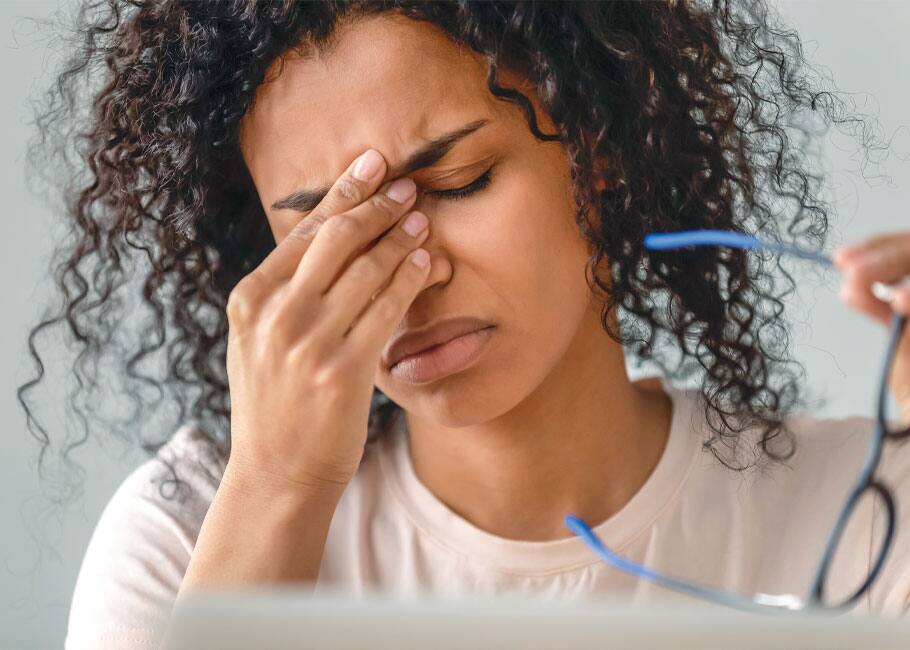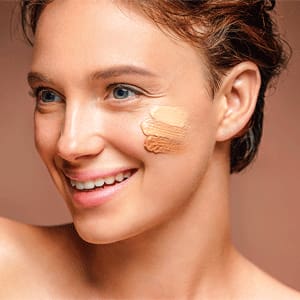Special Section // For Your Health

© fizkes / Shutterstock
Tired eyes
Using a health and beauty approach to help address what’s causing tired eyes
by HILLARY QUINN
You glance in the mirror and see dark circles, so you reach for your concealer and quickly hide the evidence. To the outside world, you look refreshed, but underneath? Those racoon eyes are still looming. That’s because zapping a beauty issue means more than applying a cosmetic bandage; it’s also about learning how to give yourself a boost from every angle so the problem truly disappears.
Sure, eyes may be the windows to the soul, yet puffiness, dark circles, droopy lids and redness can be a different sort of “pane”—signalling everything from dehydration to fatigue, stress, poor nutrition, eye strain and more. Your doctor can help evaluate symptoms, but consider trying the following expert eye-boosting tips, as well.
The health Rx
“ ‘Tired eyes’ is a simpler way to describe what doctors would call periorbital edema and reddened conjunctivae,” explains Dr. Kathy Gromer, a partner at the Minnesota Sleep Institute. “But nine times out of 10, those puffy, droopy eyelids and dark circles are caused by insufficient or poor sleep.” Here are some do’s and don’ts for decent dozing:
- Do aim for at least seven hours of zzz’s a night.
- Do exercise in the late afternoon or evening instead of the morning.
- Do stay on a consistent schedule to keep your circadian levels balanced.
- Do cut off caffeinated beverages 10 hours before bedtime. (Caffeine has a 10-hour half-life, which means 50% of the coffee you guzzle at noon will still be in your system at 10 p.m.)
- Don’t nap in the afternoon.
- Don’t try to catch up on sleep over the weekend; it will just throw you off balance on Monday.
Eat to sleep
Foods that are rich in vitamin K help reduce under-eye circles by healing damaged capillaries and improving your body’s blood-clotting abilities. Vitamin C–packed fruits and veggies can thicken the eyelid dermis, so your dark circles are less visible.
Foods to indulge in: spinach, cabbage, tofu, avocado, kale, Asian pears, oranges, strawberries, kiwi and grapefruit.
Foods to bypass: high-sodium choices, such as soy sauce and chips, as well as overly processed foods—all of which can lead to puffiness.
In your mind’s eye
You’ve likely heard the expression “You’re a sight for sore eyes.” According to Costco member Dr. Charles Samuels, medical director at the Centre for Sleep & Human Performance in Calgary, “Chronic stress and worry tends to affect our facial expression and leaves us looking tired and worn out. It is fascinating how when you relieve someone’s stress by just acknowledging their situation and giving the person the permission to feel the way they do, their face will relax and look much less tense and stressed.”
Eye boosters
If you’re endlessly staring at a computer screen, paperwork or a detailed task, try these measures:
- Take a five-minute break every 20 to 60 minutes to exercise your eyes. Circle them clockwise, counter-clockwise, vertically and horizontally.
- Place a cool cloth over your eyes and rest them.
- Wear blue-light-blocking glasses.
- Dealing with difficult situations that are stressful and may also involve conflict can also be hard on the eyes, explains Nancy Irwin, a Los Angeles–based therapist: “It may take several ‘viewing’ sessions to dial the discomfort all the way down, but bravely looking at a problem, via a meditation app and journalling, is the key to calming your eyes in every sense of the word.”
How? According to Irwin, meditation and breathing deeply and slowly with your eyes closed helps your brainwaves slow down to an alpha state, allowing them to rest while your brain works on resolving life challenges at hand. Journalling immediately afterward then allows you to process what your psyche has presented.
This kind of mindful self-care—inside and out—is the key to keeping your (healthy) eyes on the prize.

© RomarioIen / Shutterstock
Makeup magic
“People often think that when they look tired, they have to do a lot to the eyes to compensate,” says makeup artist Nick Barose. “In fact, too much under- eye concealer will actually accentuate the problem.” Try his pro tips for putting dark circles and redness into hiding:
- Apply a moisturizing concealer in a shade slightly darker than your skin tone.
- Using light “press and dab” motions, apply a small amount with a damp makeup blending sponge.
- Shift attention to other features—bold lips, for example.
- Avoid applying mascara to your bottom lashes.—HQ
Hillary Quinn (hillaryquinn.com) is a beauty and lifestyle writer.
Costco Connection: Costco offers eye care products, blue-light-blocking glasses, healthful foods, sleep aids and cosmetics in Costco warehouses and at Costco.ca.

